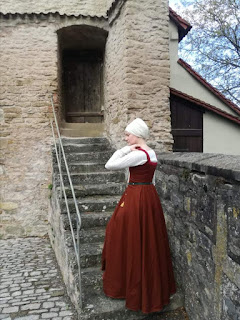söndag 31 mars 2019
Detachable sleeves?
Sometimes, when things dont go as planned, you have to make last minutes adjustments. At a very hot banquet my new dress lost its sleeves. With a room full of people making the temperature go up I needed a cooler dress. But sleeveless underdresses are seen in German images from the period so its okey. The sleeves where attatched to the dress with basting stitches and neither the dress nor sleeves where harmed during the event. With knives all sleeves are detachable, right ;)
fredag 8 mars 2019
Unterrock with cut-on bodies
 This week I finaly finished my new kirtle, or unter rock as it is called in german. When I make my dresses I often look at a painting, make my own patterns and try to make it look the same. But this time I thought it would be fun to use an actual 16th century pattern. So, when the opportunity came with the Master Tailor's manuscripts published in Drei Schnittbucher I used one of its patterns. Its younger then what I normaly do, the Tailor´s book of Enns is from the 1590. The pattern used is Fraüen under Rock side 238-241 and is a frankish style dress, my part of Germany even though the tailor book is Austrian. It has a cut-on bodice instead of a loose skirt fixed with pleats to the bodice. And it is really good as a unterrock because the pleats are on the inside of the bodies and that will make it really easy and comfortable to wear another dress on top of it. So if you made your bodies on your kirtle in a different lenght then your gown that wont be a problem. I have than that a few times...
This week I finaly finished my new kirtle, or unter rock as it is called in german. When I make my dresses I often look at a painting, make my own patterns and try to make it look the same. But this time I thought it would be fun to use an actual 16th century pattern. So, when the opportunity came with the Master Tailor's manuscripts published in Drei Schnittbucher I used one of its patterns. Its younger then what I normaly do, the Tailor´s book of Enns is from the 1590. The pattern used is Fraüen under Rock side 238-241 and is a frankish style dress, my part of Germany even though the tailor book is Austrian. It has a cut-on bodice instead of a loose skirt fixed with pleats to the bodice. And it is really good as a unterrock because the pleats are on the inside of the bodies and that will make it really easy and comfortable to wear another dress on top of it. So if you made your bodies on your kirtle in a different lenght then your gown that wont be a problem. I have than that a few times...
I used waxed white linen thread and backstitch. The seam allowance is folded down and whip stitched.
A dress with a cut-on bodies has the pleats on the inside of the dress. The unter rock has quite small pleats while patterns for gowns in Drei Schnittbucher has bigger pleats. My guess is thats because the gown could have a fuller skirt then the kirtle.
I hidden the pleats inside the lining of the bodies.
The hem is stiffened with a narrow bias cut piece of wool in the same colour. Janet Arnold describe this in Patterns of Fashion, on the Elenora of Toledo gown. This one is much more simple but I thought that was suitable when my dress is suppost to belong to a woman of another social status then Eleonora of Toledo. It takes a lot of extra time but the skirt moves beautifully.
My manikin is a bit bigger then me... The neckline has a lower cut then the dress from the book but I wanted to be able to use it together with my other dresses.
I made the arms to narrow and needed to put in a gore in the back. This was one of the most difficut patterns I haveworked with, but in the end it turned out great I think.
Prenumerera på:
Inlägg (Atom)









